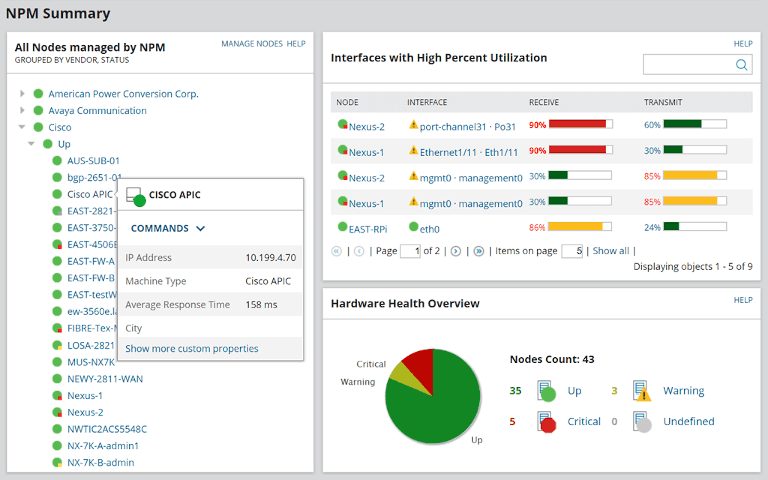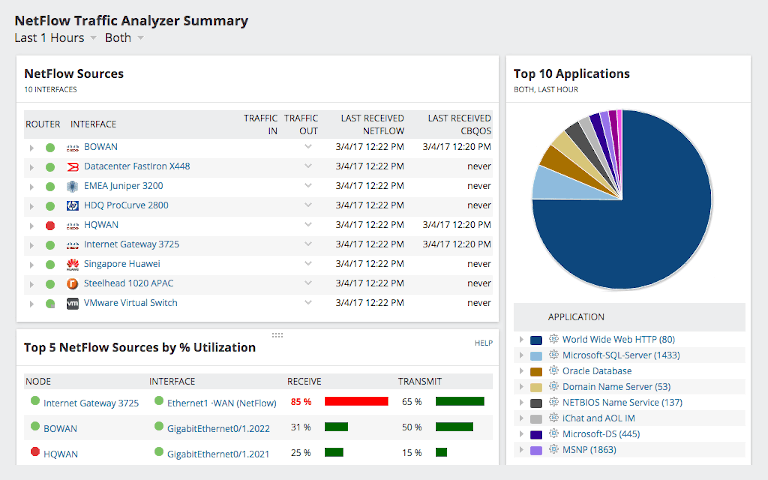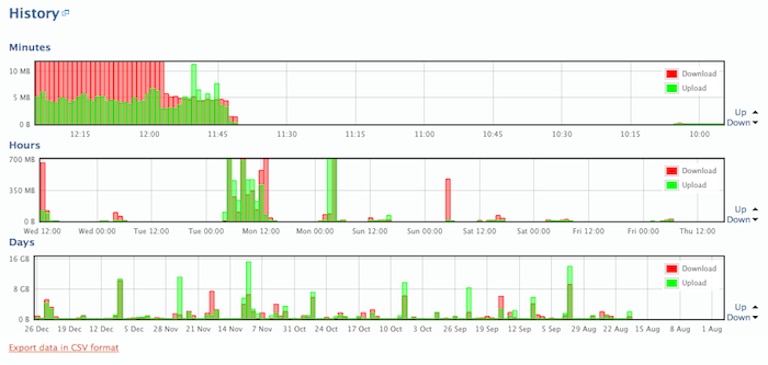Today, every organization depends heavily on its IT team to ensure unhindered connectivity and productivity. The team is responsible for managing different users, devices, and servers and maintaining high availability for mission-critical applications. Bandwidth monitoring and management play a crucial role in meeting these goals.
What Is Bandwidth Monitoring?
The bandwidth of a network can be defined as the capacity of a network to transmit data to-and-fro between different nodes within a time frame. It’s normally measured in bits per second (bps) or its higher multiples, i.e., kilobits per second, megabits per second, etc. A high bandwidth network can allow higher throughput and data transfer in a second. However, even high bandwidth networks can face latency, congestion, jitters, packet drops, and other network issues. Teams have to rely on a wide range of network bandwidth monitoring tools to diagnose and address these issues. Network analysis tools help network engineers spot high-traffic processes, nodes, devices or users choking the network bandwidth and excessively using the resources.
Common Issues Affecting Network Bandwidth
Latency
Network latency is the time a data packet takes for its transfer from source to the destination. To a large extent, latency depends on the number of network devices a data packet has to cross (also termed as the number of hops) for a successful transfer. A poor network design (e.g., using a wrong topology), malfunctioning switches/routers, and other infrastructure issues can lead to high latency in a network.
Jitter
Jitter is another bandwidth issue closely related to network latency. A jitter in a network refers to frequent latency variations, as a result of which some packets travel faster than others. As a result of jitter, sometimes a destination node has to process more packets during certain periods, while at others it could be idle. In certain time-sensitive applications (e.g., audio, video apps), jitter can significantly impact the user experience. A lot of systems use buffering to overcome jitter.
Network Devices
Routers, switches, and firewalls are the most common network devices in any business network; yet their configuration issues lead to frequent security and connectivity related issues. It may be noted, every network is designed for a certain throughput and all devices connected in the network should support this maximum throughput. If a device supporting higher throughput is connected to a lower throughput device, it can lower the overall performance of a network.
Top Tools for Bandwidth Monitoring
As discussed, there’s a wide range of network and bandwidth monitoring solutions available in the market. We’ll discuss some of these tools briefly, mentioning their key features and highlights:
1. Network Performance Monitor

SolarWinds® Network Performance Monitor (NPM) allows admins to take immediate action into network slowdowns. NPM makes it easy for admins to understand the critical network paths and pinpoint issues related to bandwidth. The tool offers a link analysis feature, using which admins can view the entire path from source to destination. The tool shows all the devices, applications and networks in a single dashboard and helps in finding network problems quickly. The network mapping feature of NPM is designed to create custom maps, wireless heatmaps and visual packet paths for better understanding. The tool can also generate customized network performance reports and let the admins get to the root cause of the problems with timely network alerts. In short, NPM is one of the best tools for monitoring the performance of the network and resolving issues affecting network bandwidth.
2. NetFlow Traffic Analyzer

SolarWinds NetFlow Traffic Analyzer (NTA) is an advanced bandwidth monitoring tool allowing admins to monitor traffic patterns and avoid bandwidth bottlenecks. It offers visual flow data to help you visually correlate various traffic-related datapoints. The pictorial representation makes it simple to analyze traffic data and monitor bandwidth usage by application, protocol, and IP address groups. You can also monitor bandwidth consumption across individual ports, source and destination IPs, and also network protocols. Further, NTA also allows you to keep a tab on the Wireless LAN Controller traffic and spot the clients choking the wireless network. NTA also allows you to create customized reports on bandwidth usage, so your organization can make better decisions for bandwidth management.
3. Network Bandwidth Analyzer Pack

If you want to have complete control and visibility into your network, you might need more than a traditional bandwidth monitoring solution. In modern networks, it’s essential to not only respond to network issues but also ensure issues don’t arise frequently. To achieve this goal, you need to constantly monitor and optimize your network and have capabilities to predict future events. Network Bandwidth Analyzer Pack (BAP), a bundled offering of SolarWinds NetFlow Traffic Analyzer and Network Performance Monitor, provides you with these capabilities. With the SolarWinds BAP, you can create a centralized network operations center to detect, diagnose, and resolve a myriad of network issues with quick collaboration and increased proactiveness.
4. BitMeter OS

BitMeter OS is another popular bandwidth monitoring solution. With BitMeter OS, bandwidth information can be monitored either via a web browser or through a Command-line tool. This open-source solution supports major platforms like Windows, Mac OSX and Linux. The tool displays the information in the form of a graph which is updated every second to provide real-time visibility into your network’s connections. Customized alerts can be defined to see when internet usage exceeds the upper limit. The tool provides flexibility to export the results to a spreadsheet for a detailed analysis.
5. Ntopng

Ntopng is the next-generation version of ntop. This simple tool is based on libpcap and can run virtually on Unix platform, MacOSX, and Windows. This tool allows admins to segregate network traffic based on certain criteria like port, IP address, L7 protocol and autonomous systems etc. With ntopng platform, the network traffic can be displayed in real time. This helps the admins to understand trends and generate timely reports to review data. The tool is well equipped to provide basic functionality and isn’t as robust as other tools.
Conclusion
Regardless of the size or budget, every company should have a bandwidth monitoring software in their arsenal. These tools will help to monitor the bandwidth effectively, identify the potential bottlenecks and save the resources of the company. A good bandwidth monitoring software will let the admins examine the current state of the network and take full control over it.
